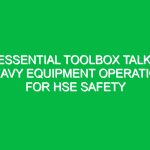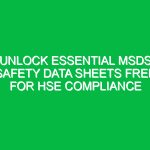Understanding Medical Surveillance in the HSE Context
Medical surveillance refers to a systematic approach to monitoring the health and well-being of employees, particularly those exposed to potential Hazards in the workplace. In the Health, Safety, and Environment (HSE) domain, medical surveillance plays a critical role in ensuring that workers remain healthy and safe while performing their duties. This proactive approach not only helps in identifying health issues early but also promotes a culture of Safety within organizations. As we delve into the nuances of medical surveillance, we will explore its significance, methodologies, and Best Practices to enhance Workplace Safety and health outcomes.
The Importance of Medical Surveillance in HSE
Implementing a robust medical surveillance program is essential for various reasons. First and foremost, it provides a framework for early detection of work-related illnesses and injuries. By regularly monitoring employees’ health, organizations can identify trends or potential health risks associated with specific job functions or environmental factors. This proactive monitoring is crucial in industries such as construction, manufacturing, and healthcare, where workers may encounter hazardous materials or stressful conditions.
Additionally, medical surveillance helps organizations comply with legal and regulatory requirements. Many jurisdictions mandate that employers conduct regular health assessments for employees exposed to specific risks. Failure to adhere to these Regulations can result in severe penalties, including fines and litigation. Hence, effective medical surveillance not only safeguards employees but also protects the organization from legal repercussions.
Key Components of Medical Surveillance
To effectively implement medical surveillance, organizations must focus on several key components:
- Health Assessments: These assessments typically include medical histories, physical examinations, and laboratory tests to evaluate employees’ health status.
- Exposure Monitoring: This involves tracking employee exposure to hazardous substances or conditions, often through environmental monitoring or direct exposure measurements.
- Data Analysis: Organizations must analyze collected health data to identify trends and correlations between workplace exposure and employee health outcomes.
- Follow-Up Procedures: Establishing protocols for follow-up care is essential for employees who exhibit symptoms or have been exposed to specific Hazards.
- Employee Education: Providing Training and resources to employees about health risks and preventive measures fosters a culture of Safety.
Benefits of Medical Surveillance
The Benefits of an effective medical surveillance program extend beyond mere compliance. Here are some key advantages:
- Enhanced Employee Health: Regular health monitoring helps identify potential health issues early, allowing for timely intervention and treatment.
- Increased Productivity: Healthy employees are generally more productive. By minimizing health-related absences, organizations can improve overall workforce efficiency.
- Reduced Workers’ Compensation Costs: Employers can lower their insurance premiums and compensation costs by proactively managing health risks.
- Improved Morale: When employees feel cared for and their health is prioritized, it enhances morale and job satisfaction.
- Regulatory Compliance: Maintaining compliance with industry regulations reduces legal risks and enhances the organization’s reputation.
Best Practices for Implementing Medical Surveillance
To maximize the effectiveness of medical surveillance, organizations should consider the following Best Practices:
1. Develop a Comprehensive Policy
Establishing a clear policy that outlines the objectives, procedures, and responsibilities related to medical surveillance is crucial. This policy should align with the organization’s overall health and safety goals and comply with relevant regulations.
2. Engage Qualified Health Professionals
Involving qualified Occupational Health professionals is essential for conducting accurate health assessments and interpreting results. These experts can provide insights into the specific health risks associated with different job roles and recommend appropriate preventive measures.
3. Foster a Culture of Safety
Encouraging open communication about health and safety concerns creates an environment where employees feel comfortable discussing their health. Regular training sessions and workshops can reinforce the importance of medical surveillance and employee participation in safety programs.
4. Utilize Technology for Monitoring
Leveraging technology can streamline the medical surveillance process. Digital health records, mobile health applications, and data analytics tools can enhance data collection, analysis, and reporting, making it easier to identify trends and patterns in employee health.
5. Regularly Review and Update the Program
A medical surveillance program should not be static. Regular reviews and updates based on emerging health risks, regulatory changes, and employee feedback ensure that the program remains relevant and effective.
Identifying Hazards and Risks in Medical Surveillance
While medical surveillance is designed to protect employees, certain hazards and risks must be considered to optimize its effectiveness:
1. Data Privacy Concerns
Handling sensitive health information requires strict adherence to privacy regulations such as HIPAA in the United States or GDPR in Europe. Organizations must implement robust data protection protocols to safeguard employee health records.
2. Incomplete Data Collection
Inadequate or inconsistent data collection can lead to misguided conclusions about employee health. Organizations should ensure that all health assessments are thorough and that data is consistently recorded and updated.
3. Resistance from Employees
Some employees may feel uncomfortable participating in medical surveillance due to privacy concerns or fear of repercussions. Building trust through transparent communication about the program’s purpose can help mitigate resistance.
Regulations and Standards Governing Medical Surveillance
Several regulations govern medical surveillance practices in various industries. Understanding these legal requirements is essential for compliance and risk management:
1. Occupational Safety and Health Administration (OSHA)
In the United States, osha sets forth guidelines for medical surveillance, particularly in industries where employees are exposed to hazardous substances. Employers must follow these guidelines to ensure the health and safety of their workforce.
2. The Control of Substances Hazardous to Health (COSHH)
In the UK, COSHH regulations require employers to assess the risks related to hazardous substances and implement appropriate medical surveillance measures to protect workers.
3. National Institute for Occupational Safety and Health (NIOSH)
NIOSH provides recommendations and guidelines for medical surveillance in various occupational settings, aiming to promote safe and healthy work environments.
Conclusion
In summary, medical surveillance is a vital component of the Health, Safety, and Environment (HSE) framework. By systematically monitoring employee health, organizations can detect potential health issues early, enhance Workplace Safety, and foster a culture of proactive health management. Implementing best practices and adhering to regulatory requirements ensures that medical surveillance programs are effective and compliant. As we continue to advance in Workplace Safety, prioritizing medical surveillance will not only safeguard employee health but also contribute to the overall success of the organization. Embracing this approach is not just a regulatory requirement; it is a commitment to creating a safer, healthier work environment for everyone.


